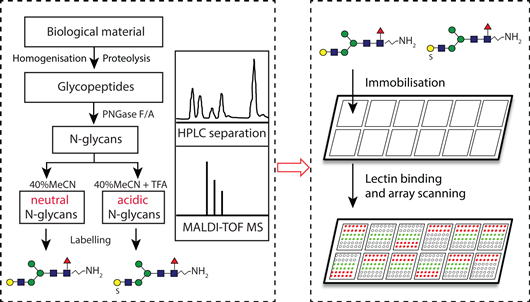Microarrays of natural and remodelled glycans
SUPERVISOR: IAIN WILSON
Background:
Glycans cover the surfaces of all cells and are involved in a wide-range of cell-cell and host-parasite interactions; determining the natural interactions of glycans with receptors is a challenge as many important glycan ligands are only available in low quantities from natural sources. Also, current glycan arrays focus on mammalian glycans and not on those from non-mammalian systems of biotechnological or immunological relevance.
Recently, we have developed a new linker for non-reductive conjugation of glycans in order to facilitate their immobilisation by non-contact printing prior to probing with lectins and antibodies (Jimenez-Castells et al., 2016). We also use the AEAB label (2-amino[N-aminoethyl]benzamide) to reductively conjugate N-glycans natural sources and probe these not only with lectins and sera of infected animals, but also with pentraxins (Hykollari et al., 2018; Martini et al., 2019). .

Aims and methods:
As many biological systems are based on single cells and these can be cultivated in the laboratory, the goal here is to prepare glycans from different single cell or ‘unicellular’ systems, such as the Trichomonas vaginalis and Trypanosoma cruzi parasites, Leishmania tarantolae protist expression system, the yeast Pichia pastoris, insect and snail cell lines as well as wild-type and mutant mammalian cell lines. N-glycans can be released with PNGases F or Ar or with hydrazine (Yan et al, 2018), O-glycans by household bleach, glycosaminoglycan-like chains by hydrazine (Vanbeselaere et al., 2018) and the glycan moieties of glycolipids released by glycoceramidase or bleach; short oligosaccharides can be remodelled to generate NeuAc/NeuGc-modified or fucosylated forms (Jimenez-Castells et al., 2016).
These glycans will be derivatised either reductively or non-reductively with a fluorescent linker (such as AEAB or our own linker), purified by HPLC, structurally verified by MALDI-TOF-MS/MS and non-contact printed onto NHS-derivatised glass slides. These can then be probed with (i) anti-carbohydrate antibodies and sera from parasite-infected animals, (ii) pentraxins (such as human serum amyloid P or C-reactive protein; see Hykollari et al, 2018 and Martini et al, 2019), (iii) standard commercial lectins, (iv) fungal and human galectins and C-type lectins (such as fungal CGL2, human MBL or human DC-SIGN) or (v) with virus-like particles. Expression of glycosyltransferases/glycosidases, glycan preparation and analysis, array printing and probing will be the primary methods; bioinformatic tools will also be employed to ‘cluster’ the results of this novel ‘unicellular’ glycan array. The unprecedented set of glycans probed with a variety of proteins will expand our knowledge about which glycans are ligands for various antibodies and lectins, highlighting epitopes of immunological relevance or improving the basis for lectin-based screens in both mammalian and non-mammalian systems.
Collaborations within this thesis will include Reingard GRABHERR, Nicole BORTH and Eva STÖGER for cell lines, recombinant proteins or bacterial polysaccharides.
REFERENCES:
Hykollari, A., Malzl, D., Eckmair, B., Vanbeselaere, J., Scheidl, P., Jin, C., Karlsson, N.G., Wilson, I.B.H., Paschinger, K. (2018) Isomeric Separation and Recognition of Anionic and Zwitterionic N-glycans from Royal Jelly Glycoproteins. Mol Cell Proteomics. 17, 2177-2196. doi: 10.1074/mcp.RA117.000462.
Jimenez-Castells, C., Stanton, R., Yan, S., Kosma, P., Wilson, I.B.H. (2016) Development of a multifunctional aminoxy-based fluorescent linker for glycan immobilization and analysis. Glycobiology 26, 1297-1307; doi: 10.1093/glycob/cww051
Martini, F., Eckmair. B., Neupert, C., Štefanić, S., Jin, C., Garg, M., Jiménez-Castells, C., Hykollari, A., Yan, S., Venco, L., Varón Silva, D., Wilson, I.B.H. and Paschinger, K. (2019) Highly modified and immunoactive N-glycans of the canine heartworm. Nature Communications, 10:75, doi: 10.1038/s41467-018-07948-7
Vanbeselaere, J., Yan, S., Joachim, A., Paschinger, K., Wilson, I.B.H. (2018) The parasitic nematode Oesophagostomum dentatum synthesizes unusual glycosaminoglycan-like O-glycans. Glycobiology, in press. doi: 10.1093/glycob/cwy045
Yan, S., Vanbeselaere. J., Wöls, F., Jin, C., Blaukopf, M., Wilson, I.B.H., Paschinger, K. (2018). Core richness of N-glycans of Caenorhabditis elegans: a case study on chemical and enzymatic release. Anal Chem. 90, 928-935. doi: 10.1021/acs.analchem.7b03898
